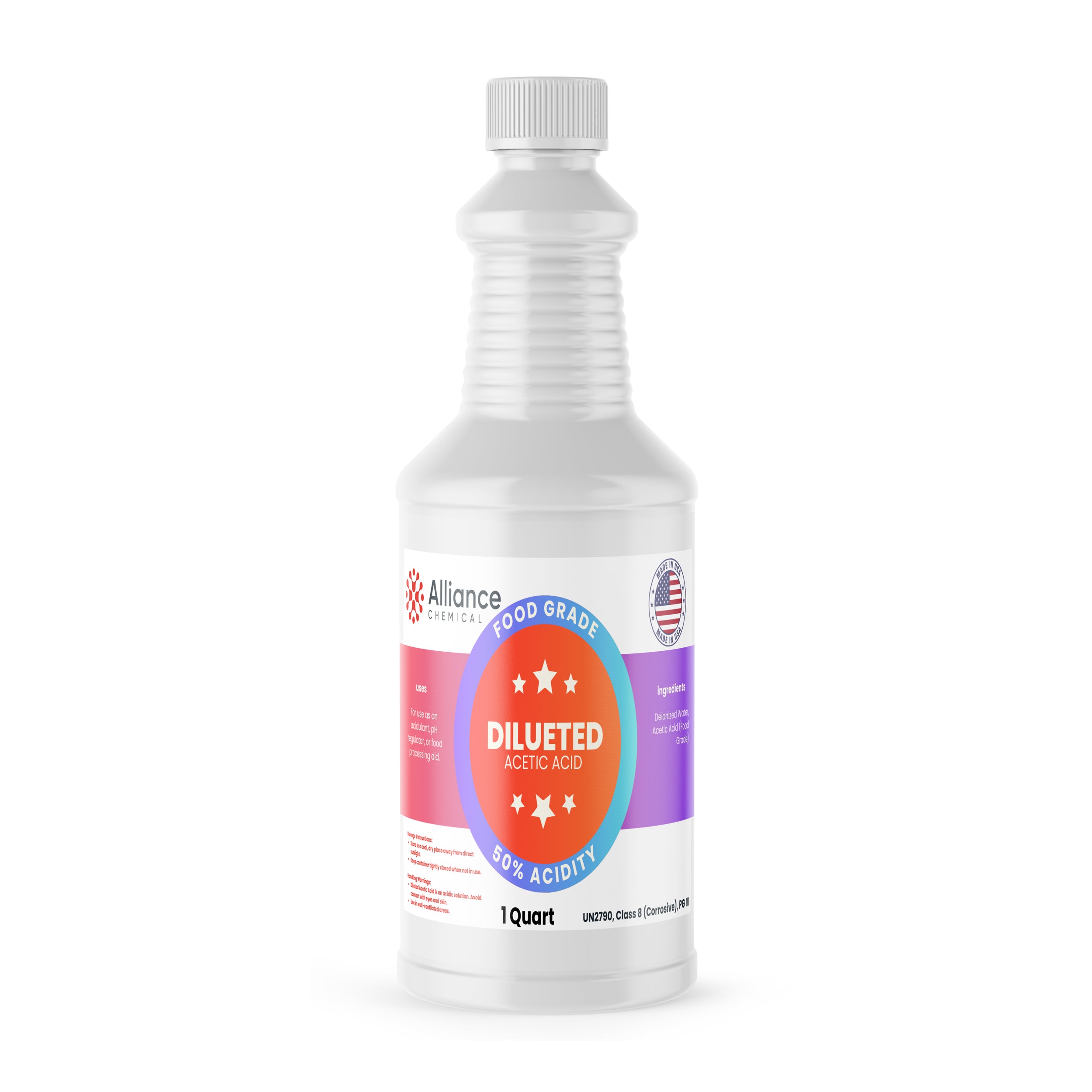Ask a question
Product Overview
50% Diluted Acetic Acid Food Grade is a clear, colorless solution of acetic acid at half strength, designed for food processing and preservation. Its solution concentrates the activity of acetic acid (CH₃COOH) while delivering manageable handling properties for industrial use. The product is formulated to meet food-grade standards and provides reliable acidity (pH ~2.4 for a 0.5 w/w solution) essential for microbial control, flavor modulation, and pH adjustment in a range of applications. Typical assay is 50% with a tight specification window (49–51%), ensuring consistent acidity and performance across batches. The material exhibits a pungent vinegar-like odor typical of acetic acid and demonstrates full miscibility with water for versatile integration into process streams and cleaning regimens.
The 50% solution is commonly used in food preservation, flavor enhancement, and as a pH adjuster in food manufacturing, while also serving as a cleaning agent in food-service environments due to its degreasing properties. This grade emphasizes controlled contaminants to support food safety and regulatory compliance, including low heavy metals and limited anions. The product is stored under controlled conditions to maintain quality, with a shelf life of 24 months from manufacture when stored properly.
Key Properties
- Appearance: Clear, colorless liquid
- Chemical Formula: CH₃COOH
- Molecular Weight: 60.05 g/mol
- Boiling Point: 100–118°C
- Specific Gravity (20°C): 1.02–1.04 (typical 1.03)
- Specific Gravity (25°C): 1.024–1.043 (typical 1.033)
- Assay (wt%): 49–51% (typical 50%) — test method: titration with standardized NaOH
- Color (APHA/Hazen): max 10 (typical 5) — test method: APHA/Hazen visual comparison
- Residue After Ignition: max 0.05% (typical 0.01%) — test method: gravimetric ashing at 450°C
- Chloride (Cl⁻) ppm: max 2000 (typical 500) — test method: IC or argentometric titration
- Nitrate/Nitrite (NO₃⁻) ppm: max 1000 (typical 100) — test method: IC
- Ammonium (NH₄⁺) ppm: max 100 (typical 10) — test method: IC or colorimetric assay
- Sulfate (SO₄²⁻) ppm: max 5000 (typical 200) — test method: IC
- Phosphate (PO₄³⁻) ppm: max 500 (typical 50) — test method: IC
- Arsenic (As) ppm: max 3 (typical 0.5) — test method: ICP-MS
- Heavy Metals (as Pb) ppm: max 5 (typical 0.5) — test method: ICP-MS
- Iron (Fe) ppm: max 0.5 (typical 0.05) — test method: ICP-OES
- Copper (Cu) ppm: max 0.2 (typical 0.05) — test method: ICP-OES
- Manganese (Mn) ppm: max 0.5 (typical 0.05) — test method: ICP-OES
- Nickel (Ni) ppm: max 0.5 (typical 0.05) — test method: ICP-OES
- Lead (Pb) ppm: max 5 (typical 0.5) — test method: ICP-OES
- Zinc (Zn) ppm: max 5 (typical 0.5) — test method: ICP-OES
- Aluminum (Al) ppm: max 10 (typical 1) — test method: ICP-OES
- Chromium (Cr) ppm: max 2 (typical 0.2) — test method: ICP-OES
- Cobalt (Co) ppm: max 1 (typical 0.1) — test method: ICP-OES
- Calcium (Ca) ppm: max 2000 (typical 200) — test method: ICP-OES
- Magnesium (Mg) ppm: max 1000 (typical 100) — test method: ICP-OES
- Sodium (Na) ppm: max 1000 (typical 100) — test method: ICP-OES
- Potassium (K) ppm: max 1000 (typical 100) — test method: ICP-OES
- Substances Reducing Permanganate: Passes test — test method: KMnO₄ time test
- Sulfurous Acid (H₂SO₃) ppm: max 10 (typical 2) — test method: titrimetric reduction or colorimetric inference
- pH (0.5 w/w 50% solution): ~2.4 — range 2–3
Common Applications
- Food Preservation: Used to inhibit microbial growth in dressings, sauces, marinades, and ready-to-eat products with controlled acidity.
- Flavoring Agent: Imparts characteristic vinegar-like notes essential for certain formulations in condiments and dressings.
- pH Adjuster (Food Manufacturing): Adjusts acidity for taste optimization, texture control, and preservation efficiency in process streams.
- Cleaning Agent (Food Service): Degreasing and sanitizing action in equipment and surfaces, compatible with many rinse processes when used as directed.
- Fermentation Aid (Beverage Production): Serves as a nutrient source and acidity modulator in fermentation workflows to support yeast metabolism.
- Ingredient for Brine and Pickling Systems: Contributes to flavor, texture, and microbial stability in brines and pickling processes.
Safety Precautions
Handle with appropriate PPE including chemical-resistant gloves and splash protection. Store in a cool, dry place away from direct sunlight in HDPE or glass containers to maintain integrity and minimize container reactions. Ensure adequate ventilation during handling to reduce inhalation exposure; avoid contact with strong bases and oxidizers to prevent reactive hazards.
Emergency and exposure considerations: In case of skin or eye contact, rinse immediately with abundant water for at least 15 minutes and seek medical attention. If inhaled, move to fresh air and seek medical evaluation if symptoms persist. If ingested, rinse mouth and do not induce vomiting; obtain medical assistance promptly. Refer to the Safety Data Sheet for UN 2789 classification, first-aid guidance, and spill response procedures.
Benefits
✔ Consistent Food-Grade Quality – Meets food-grade specifications with tight assay control and low heavy metal content for safe consumption in processing environments.
✔ Reliable Acidity and Flavor Modulation – Delivers predictable acidity (pH ~2.4 for 0.5 w/w solution) and characteristic vinegar notes for flavor and preservation applications.
| Property | Value |
|---|
M3W-P8X-K6T
$32.00
Unit price
Compare Products
| Price |
|---|
| SKU |
| Rating |
| Discount |
| Vendor |
| Tags |
| Weight |
| Stock |
| Short Description |

















